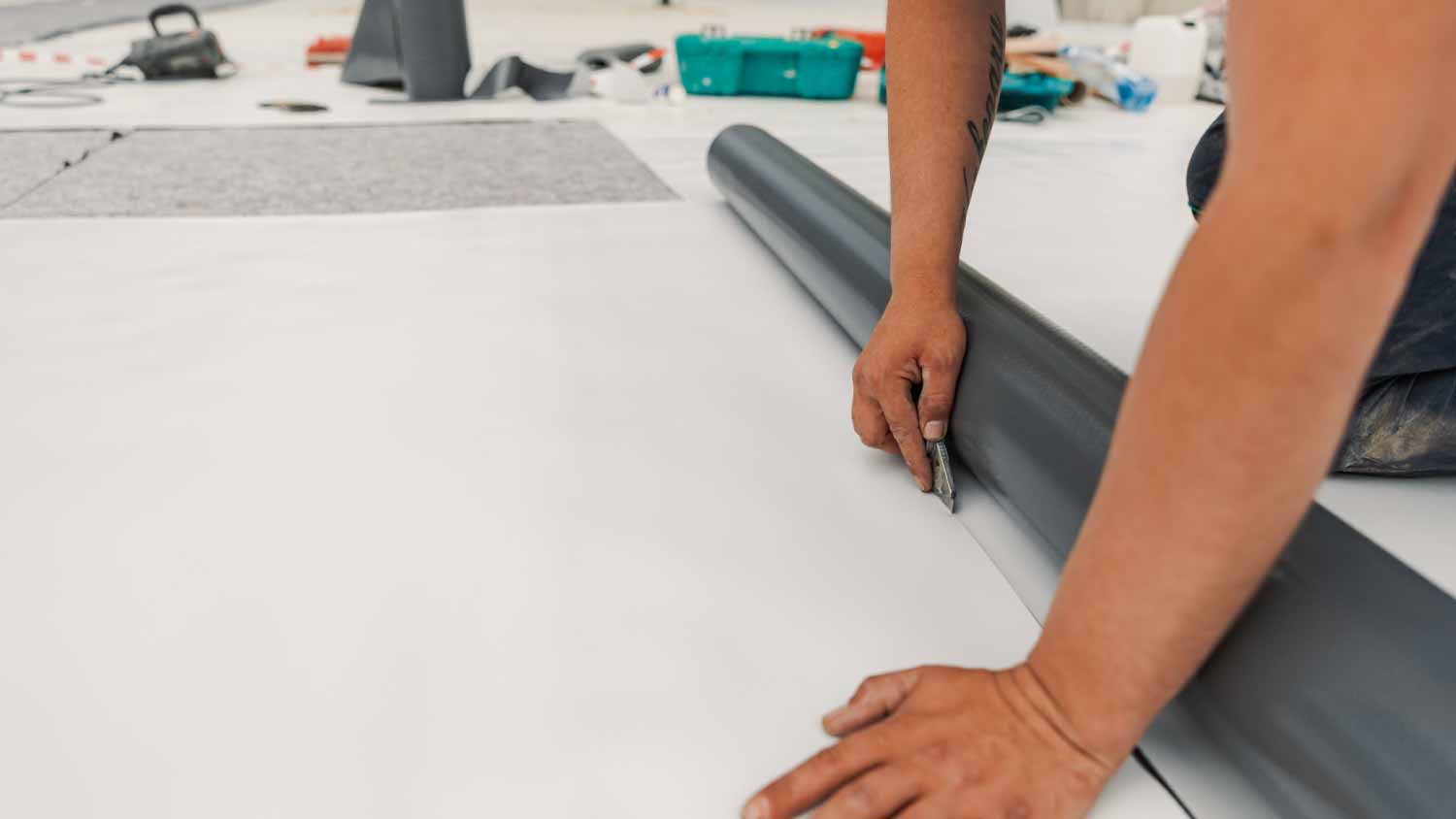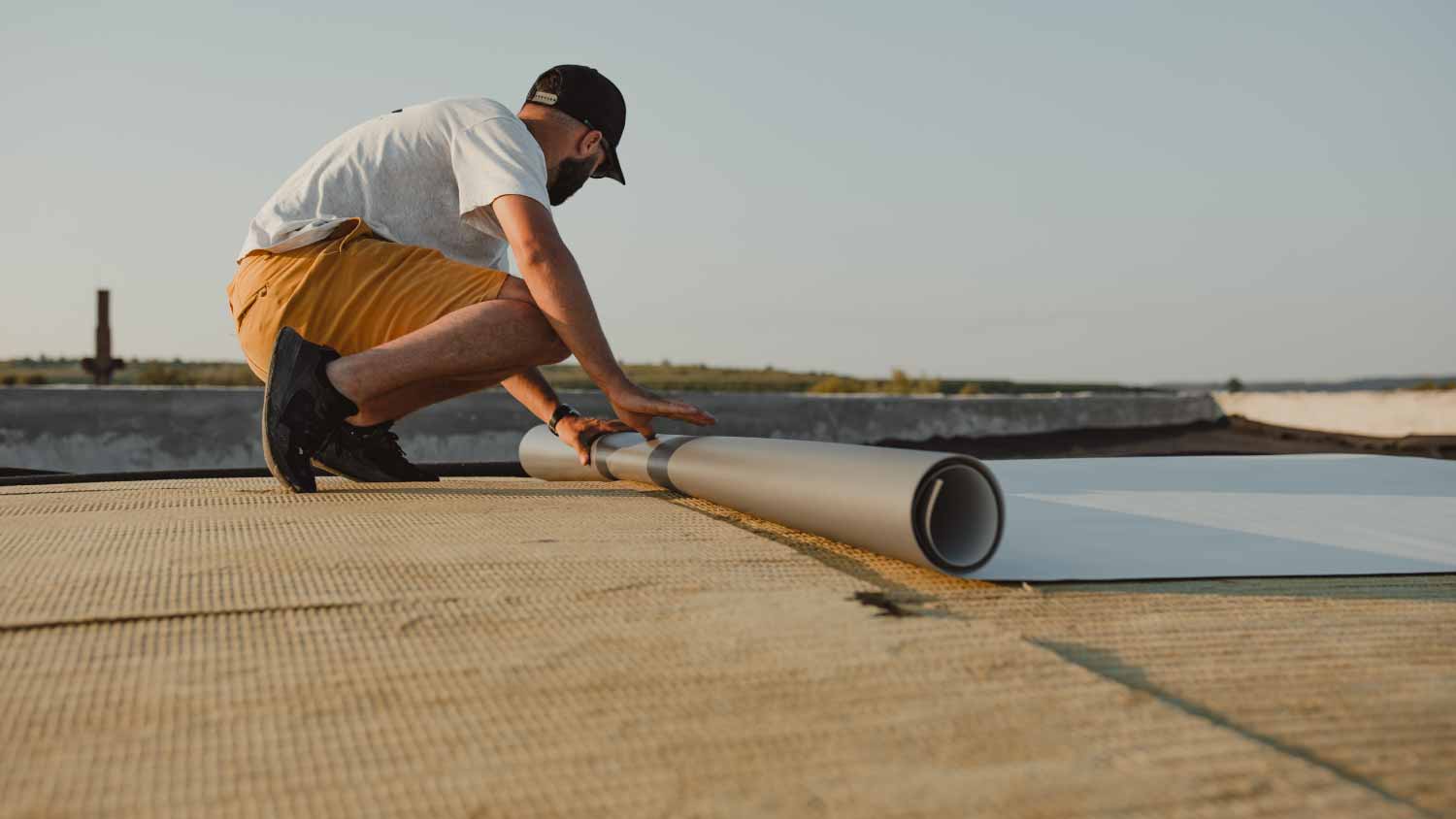TPO vs. PVC Roofing: What’s The Difference?
Acronyms are about the only thing these two have in common


TPO has a shorter lifespan than PVC.
PVC is less environmentally friendly, although it is recyclable.
TPO roofs are more energy-efficient in hot, sunny climates.
PVC roofs are more resistant to punctures and are less likely to leak.
TPO and PVC roofs are increasingly popular flat roof replacements, and although they’re similar in many ways, there are some important things to understand before you choose one. In this guide, we’ll explain the differences between TPO and PVC roofing to help you choose the best fit for your building.
TPO vs. PVC Roofing: Key Differences
Thermoplastic polyolefin (TPO) and polyvinyl chloride (PVC) are both single-ply membrane roofing materials that are suitable for flat roofs. TPO is white and reflects more sunlight than PVC, making it a more energy-efficient option in hot, sunny climates. PVC is more resistant to punctures, though, so it’s a more durable option for buildings that see extreme weather and blown debris. They cost about the same, but PVC lasts longer, so you get more value for the money.
What Is TPO Roofing?

TPO roofing is a single-ply roofing membrane with heat-sealed seams. It has a white color that reflects sunlight well, and with regular maintenance, it can remain waterproof for up to 30 years. TPO roofing is a low-maintenance option that just requires routine inspections and as-needed repairs.
| Pros | Cons |
|---|---|
| Low maintenance | Prone to punctures |
| Reflects sunlight | Shorter lifespan |
Best for:
Reducing solar heat gain in hot, sunny climates.
Homeowners looking for a low-maintenance flat roof option.
Homes in areas that don’t see extreme weather.
Pros of TPO Roofing
TPO roofs are one of the few flat roofing options that aren’t black, so they reflect sunlight well and are considered a cool roof option, according to the U.S. Department of Energy. They can help keep your building cool in sunny climates, which could reduce your cooling bills over time.
This type of roof material requires minimal maintenance, provided it doesn’t suffer from punctures. If you minimize foot traffic and live in an area that doesn’t see extreme winds or have heavy tree coverage, TPO roofs just require routine roof inspections and can last for up to 30 years.
Cons of TPO Roofing
The biggest issue with TPO roofing is that it has a shorter lifespan than PVC, especially if your area sees hurricanes or tornadoes that can blow debris onto the roof, or if you have trees that can drop debris onto it.
What Is PVC Roofing?

PVC roofing is also a single-ply membrane made from polyvinyl chloride, which is a synthetic plastic material. The roofer you hire will lay down sheets and then seal the seams with heat. The seams are highly water resistant, making PVC a good option in areas that see heavy rainfall.
| Pros | Cons |
|---|---|
| Puncture resistance | More maintenance |
| Longer lifespan | Absorbs heat |
Best for:
Buildings in areas that see more extreme weather that threatens the roof.
Homeowners looking for a longer roof lifespan and more value for their money.
Homes in colder climates, where solar heat gain is beneficial.
Pros of PVC Roofing
PVC roofing stands up better to punctures and physical wear, so it’s a more durable option in areas that are at risk of blown debris and fallen tree limbs. The greater physical resistance also means a longer lifespan, and you can get up to 30 years of life from your PVC roof.
PVC roofing is black, so it absorbs heat more readily from the sun. This can lead to higher cooling bills in the summer, but it can help reduce heating bills in colder climates.
Cons of PVC Roofing
PVC roofing requires more maintenance than TPO roofing, including resealing every 5 to 10 years and routine roof inspections to check for damages. The black color can mean reduced heating bills in colder climates, but it will come with higher cooling bills in hot, sunny climates, as the material absorbs and transfers heat more readily to your building.
TPO Roofing vs. PVC Roofing
There are a few key differences between TPO and PVC roofing to understand before you choose which is best for your building.
Appearance: Tie
TPO is white, and PVC roofs are usually black or dark gray. However, since they’re only suitable on flat roofs, neither will be visible from the street, and they won’t affect curb appeal at all.
Durability: PVC
PVC stands up better to physical damage, so it will last longer and provide more value where blown debris and regular foot traffic are concerns.
Chemical Resistance: PVC
Due to the carbon aspect of PVC construction, it’s more resistant to damage from chemicals. This makes it a better option in areas where pollution is a concern for roof health, like industrial areas.
Fire Resistance: PVC
The chlorine in PVC acts as a natural fire retardant. TPO doesn’t have this, which is why it’s much less likely to stand up to high heat.
Price: Tie
A TPO roof costs between $4.50 and $16 per square foot, or an average of $10,700 for an average-size roof. PVC roofing costs between $5 and $15 per square foot, so both will be about the same price for a similarly sized roof.
Applications: Tie
TPO and PVC roofs are both common in the U.S. for flat roof applications. TPO is the preferred option in most southern states, where the lighter color helps reduce solar heat gain, and PVC is more common in northern states that benefit from solar heat gain.
Ease of Installation: Tie
There aren’t complicated aspects of installation for either of these materials. As long as the installation professional is following instructions and isn’t installing during extreme heat, cold, or rain, the layers should seal together easily, resulting in a watertight roof.
Ease of Repair: Tie
Repairing either of these roofs involves tearing up the damaged layer and replacing it. Since both materials are fairly easy to work with, and the tools required aren’t overly complicated, they both require about the same time and effort to repair.
Length of Life: PVC
PVC roofs last for an average of 25 years, with most building owners seeing 20 to 30 years of useful life from the material. TPO roofs last for an average of just under 25 years, with a normal lifespan of between 15 and 30 years.
Eco-Friendliness/Sustainability: TPO
TPO is leaps and bounds more sustainable than PVC, which is notorious for its (negative) environmental impact. TPO is, on the surface, more sustainable and eco-friendly, but PVC is also recyclable. However, we can’t ignore that some of the materials required to make PVC are sourced from highly controversial environmental practices.
ROI and/or Resale Value: PVC
While it’s hard to calculate the exact return on investment (ROI), PVC roofs have greater durability and a longer lifespan, so they should put buyers' minds at ease when purchasing a property.
How to Choose the Right Style Roof for Your Home
Choosing between TPO and PVC for your flat roof mostly comes down to the climate in your area. TPO is the better option for building efficiency in hot, sunny climates, and it will last for 15 to 30 years if you don’t see much in the way of extreme weather. PVC is more resilient to extreme weather, so it’s better in areas that see hurricanes, tropical storms, and tornadoes that can threaten your roof with blown debris. It’s also more energy-efficient in colder climates. Speak with a roofing company near you if you’re unsure which is best in your area.
You should also consider value and ongoing maintenance needs. These roofing options come with similar flat roof replacement costs, and although PVC requires more maintenance, it lasts longer, meaning it provides more value over time.





- Roofers
- Metal Roofing
- Roof Repair
- Roof Inspection
- Vinyl Siding Repair Contractors
- Flat Roofing Companies
- Commercial Roofing
- Emergency Roofing Companies
- Leaky Roof Repair
- Metal Roof Repair
- Business Roof Repair
- Flat Roof Repair
- Tile Roof Repair
- Slate Roofers
- Rubber Roofers
- Roofing & Siding
- Metal Roof Installation
- Affordable Roofing
- Roof Sealing
- Attic Ventilation Contractors










